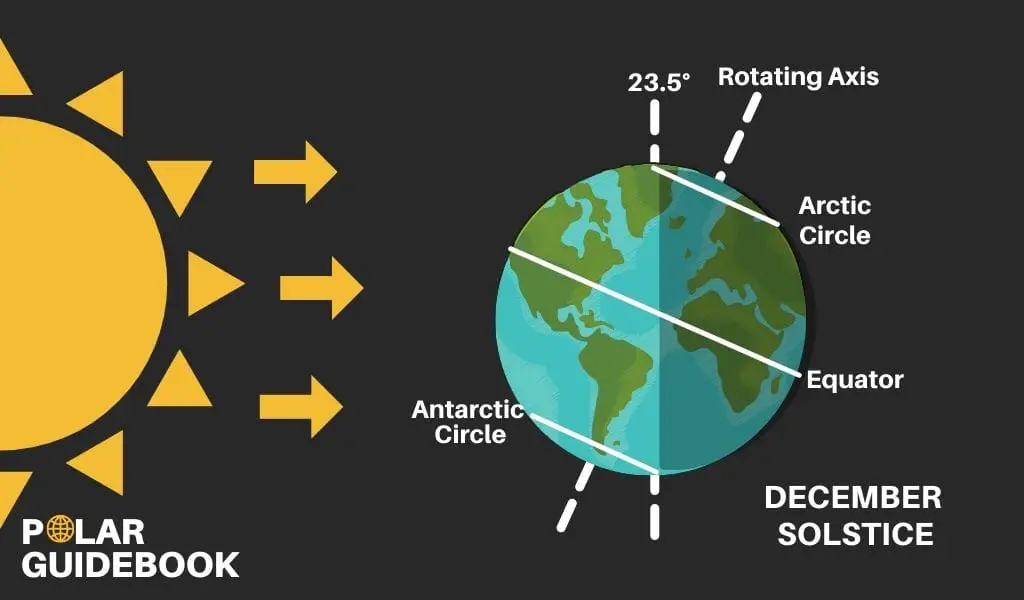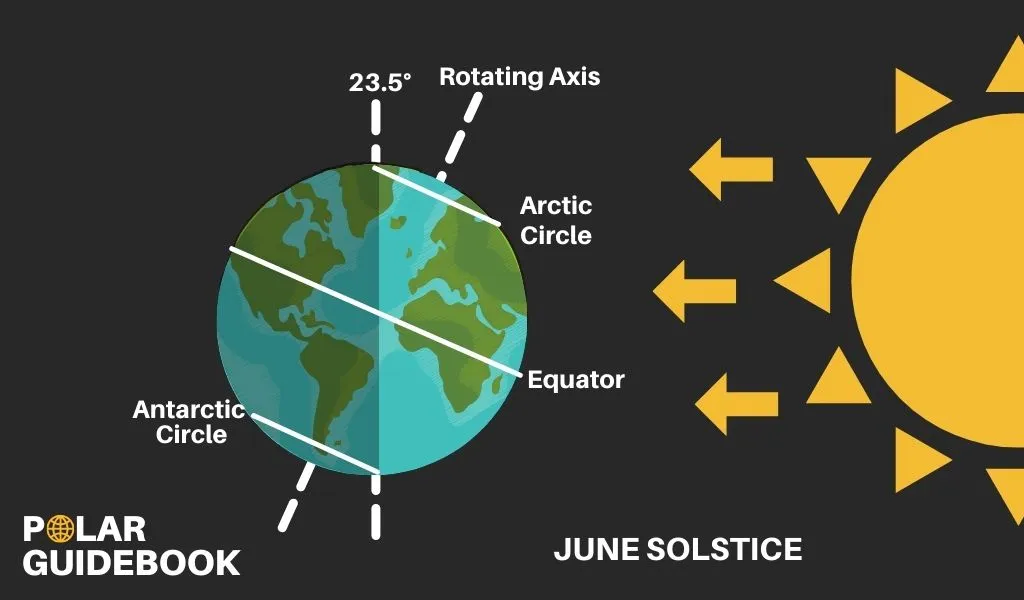The polar regions can experience more than 24 hours of daylight or nighttime at a time, with the poles experiencing up to 6 months of total darkness. So, what exactly is going on here?
Polar nights and midnight sun are natural phenomena that cause daylight at night or darkness during the day. It happens because the Earth is tilted 23.44° on its axis so areas above the Arctic Circle and below the Antarctica Circle spend parts of the year fully exposed or hidden from the sun.
Keep reading to find out more about polar nights and midnight sun, including how to work out the length of time each will last and why they cause ‘polar health disorder syndrome’.
What Are Polar Nights?
Polar nights are a natural phenomenon where the sun does not rise above the horizon for more than 24 hours, this results in darkness (or twilight) during the day. This can only be observed above the Arctic Circle or below the Antarctic Circle*.
If you’re a scientist, the proper definitions of a polar night are:
- When the sun remains below the horizon throughout a full diel cycle.
- Or, when solar elevation is lower than 0° over the 24 hour day.
Not every polar night will result in total darkness as it depends on how far below the horizon the sun is.
Once the sun remains 18° below the horizon, this results in total darkness. Anything less than this and it is twilight (when the sun is not visible but there is still some light coming over the horizon)1 (source: J. Cohen, et al., Polar Night, Marine Ecology, pp.37-66, 2020).
*Technically, polar nights do not occur directly on the arctic and antarctic circles since the calculations use the center of the sun, although, it’s close enough for a basic understanding.
What Are Polar Days (or Midnight Sun)?
Polar Days (more commonly known as Midnight Sun) are the opposite of polar nights. Midnight sun occurs when the sun does not set for more than 24 hours, resulting in daylight during the night.
Using the same format as above, you can also define polar days as:
- When the sun remains above the horizon throughout a full diel cycle.
- Or, when solar elevation is higher than 0° over the 24 hour day.
Polar nights and midnight sun occur at opposite times of the year. During the December solstice (usually the 21st or 22nd of the month), it is a polar night at the north pole and midnight sun at the south pole.
During the June solstice (also the 21st or 22nd of the month), the opposite is true as it will be a polar night at the south pole and midnight sun at the north pole.
Why Do Polar Nights and Midnight Sun Occur?
Polar Nights and Midnight Sun occur north of the Arctic Circle (66°30′ N) and south of the Antarctic Circle (66°30′ S). This is calculated mathematically and is a result of the tilt of the Earth which is 23.44° relative to our orbital plane (if there was no tilt).
The below image best demonstrates why polar nights and midnight sun occur. As you can see, the angle means that for large parts of the year, the north and south polar regions are totally obscured from the sun whereas during other parts of the year they are totally exposed.


If you’d like to learn more about the southern polar region, see our full article where we’ve pulled together 17 facts about Antarctica, including the blood-red waterfall and volcanoes that can be found there.
How Long Does a Polar Night Last?
In the arctic, polar nights are shortest just above the arctic circle and they increase in length as you move further north.
The same applies in the Antarctic, with the shortest polar night just below the Antarctic circle and increasing as you move further south.
The longest polar nights are found directly on the north and south poles where you would experience 6 months of polar nights directly followed by 6 months of midnight sun each year.
In general, the length of polar nights increases by 6 days for each degree of latitude as you move away from the Arctic and Antarctic circles2 (source: J. Cohen, et al., Polar Night, Marine Ecology, pp.37-66, 2020).
This top graph below shows the calculation in action. Remember, polar nights don’t occur directly on the Arctic and Antarctic circles as the top half of the sun will still be visible, so any given destination will experience longer midnight sun than polar nights.

How Do Polar Nights Affect Humans?
Living in the polar regions can already be stressful enough for a human being, particularly in Antarctica where long periods of isolation, confinement, and living in an extreme environment can cause symptoms such as disturbed sleep, impaired cognitive ability, and interpersonal conflict3 (source: L.A. Palinkas and P. Suedfeld, The Lancet, Vol. 371, Issue 9607, pp.153-163, 2008).
Add to this the physical impacts on the body of polar nights and you realize what a challenging environment it is to live in.
Across the rest of the world, UV light from the sun is what tops up our serotonin levels which is an important chemical in our body that causes us to be happy.
However, during polar nights in the Arctic or Antarctica, prolonged darkness can affect our serotonin and cause us to become unhappy or depressed, scientists have termed this ‘polar health disorder syndrome’ or simply, polar madness.
To combat this, doctors recommend plenty of exercise since this also helps produce serotonin and a balanced diet.
They have also been known to recommend intense bursts of artificial light to help boost serotonin. Thirty minutes of bright artificial white light in the morning can reduce the risk of polar depression4 (source: Ministry for the Development of the Russian Far East and Arctic).
Related Questions
Which Countries Experience Polar Nights and Midnight Sun?
In the northern polar region, polar nights and midnight sun occur in all 8 of the arctic countries which are Canada, Denmark (Greenland), Finland, Iceland, Norway, Sweden, Russia, and the USA (Alaska).
In the southern polar region, polar nights and midnight sun also occur in Antarctica, although this is a continent, not a country.
Where is 6 Months Day and 6 Months Night?
Directly on the north and south poles, you would experience 6 months of daylight and 6 months of darkness due to the tilt of the Earth and phenomena known as polar nights and midnight sun.
How Long is the Polar Night in Svalbard?
Svalbard is a Norwegian group of islands about halfway between mainland Norway and the North Pole. It contains the small town of Longyearbyen which is the world’s northernmost settlement5 (source: BBC, 2020).
In Svalbard, the polar night lasts for two and a half months from mid-November to January6 (source: Visit Svalbard).
Does Sweden Have Polar Nights?
Yes, approximately 15% of Sweden’s landmass is located above the arctic circle, therefore parts of the country will experience polar nights7 (source: The Arctic Insitute).
In Sweden’s northernmost city, Kiruna, the polar night lasts for about 28 days whereas the midnight sun lasts for around 50 days8 (source: Kiruna Lapland Tourist Center).
Does Canada Have Polar Nights?
Yes, Canada is one of the largest arctic countries with over 40% of its landmass above the arctic circle, therefore, large parts of Canada experience polar nights.





![Read more about the article Where is the Arctic? [4 Ways to Define it]](https://polarguidebook.com/wp-content/uploads/2021/07/where-is-the-arctic-300x176.jpg)